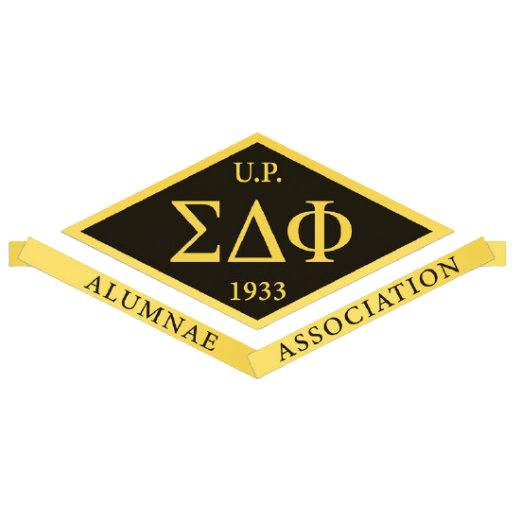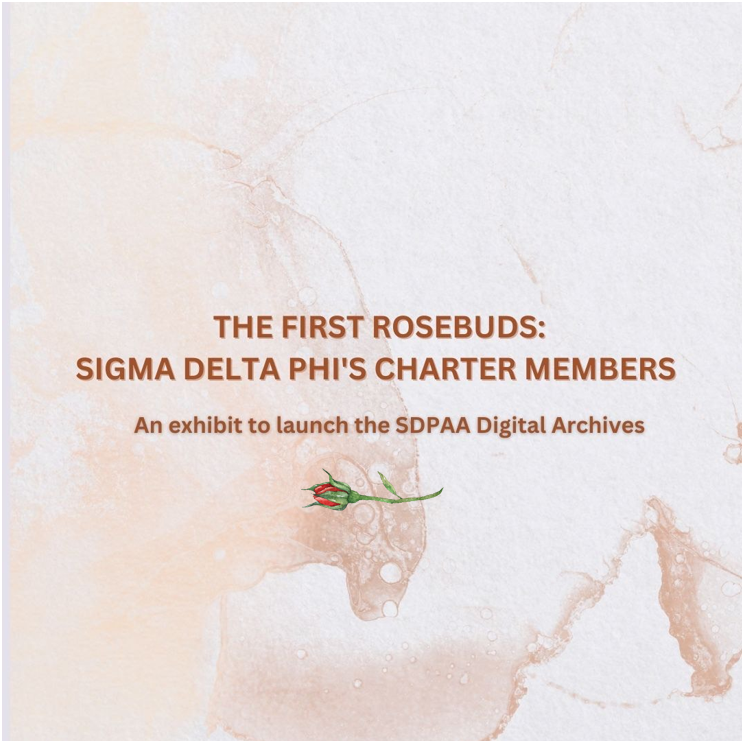
The role of women was esteemed by leaders of the 1920s and 1930s who were laying the groundwork for the incoming Republic of the Philippines.
The new secular education used clubs to accustom students to dealing, working, socializing, and sharing responsibilities with other Filipinos from around the archipelago.
Clubs focusing on careers, hobbies, sports, special interests, and civic work were to counterbalance the many existing religious lay organizations

University of the Philippines (UP)
Dean of Women Catalina Abad Santos-Manguerra selected four outstanding members from the UP Women’s Club to be Sigma Delta Phi’s founders.
Lucero was the Women’s Club treasurer;
Paredes, president; Stevenson, secretary.
Sigma Delta Phi, standing for Society of Dramatics and Fine Arts, was founded on February 24, 1931 at University of the Philippines, then located in Ermita, Manila.
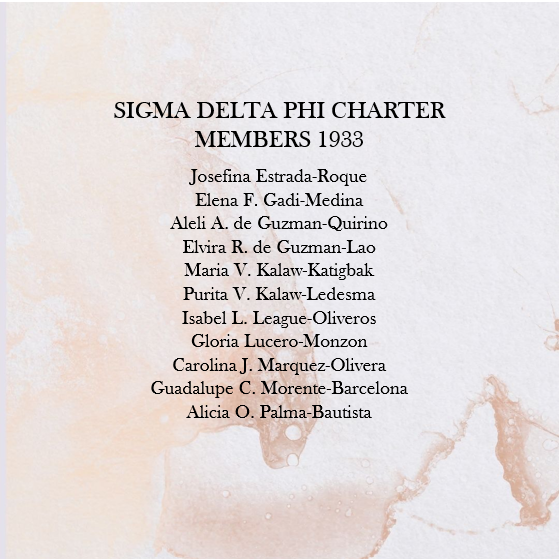
In 1933, UP officially recognized the Sorority with a charter membership of 22 distinguished coeds who included four of five founders. The young women were stand-outs, rosebuds like the Sorority’s official flower. What follows are glimpses into their lives on campus in 1933.

The years when Sigma Delta Phi began is when women’s suffrage was hotly discussed. In 1921 clubs around the islands had united into the National Federation of Women’s Clubs, a powerhouse campaigning for women’s right to vote. Some parents of Sorority members were supporters of the civic cause. It was hoped the members, too, would join.
In 1934, the new Philippine Constitution held that women could vote if 300,000 of them affirmed by ballot that it was their desire. Women stepped up their support. With 447,725 affirmative votes, women’s suffrage was legalized in the Philippines on September 17, 1937. Coed campaigning helped make it possible
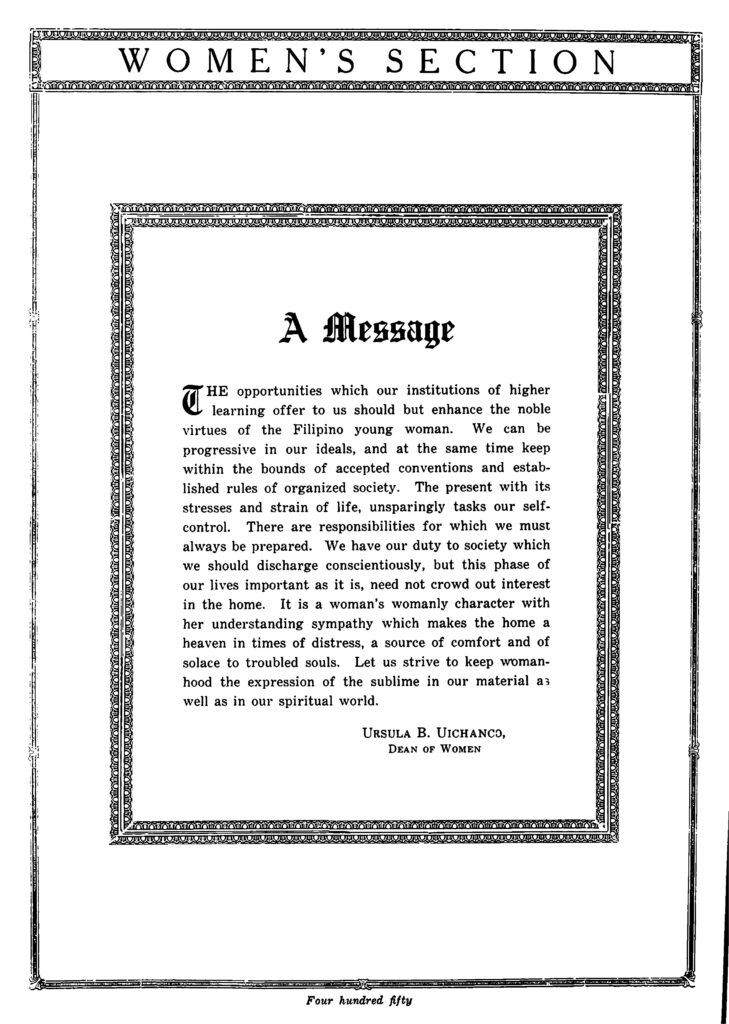
The role of the 20th century, modern Filipina was discussed openly, noting how the past and tradition were being challenged to adjust or change completely.
Women needed to develop their critical capacity and civic commitment.

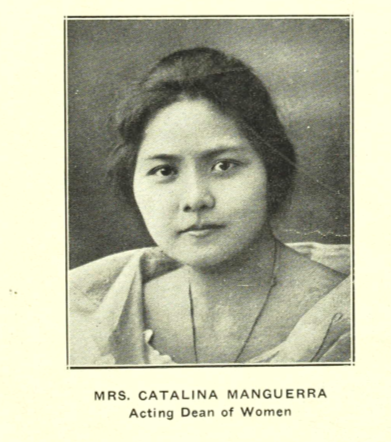
CATALINA ABAD SANTOS-MANGUERRA
CO-FOUNDER
She was the highly respected UP Dean of Women in 1931. She earned an Associate in Arts in 1918, a High School Teacher’s Certificate in 1919 , and a Bachelor of Science in Education in 1920.
Dean Manguerra selected four members of the UP Women’s Club to found Sigma Delta Phi with her in 1931.
She was born to Vicente Abad Santos and Toribia Basco of Guagua, most likely in San Fernando, Pampanga. One of her nine siblings was Jose Abad Santos (1886-1942), an Upsilonian, who became a Chief Justice and a martyr against the Japanese Occupation during World War II. She married Mariano Flores Manguerra, a civil engineer who graduated from Valparaiso University in Indiana and, upon returning, taught at UP. They had no children.
Dean Manguerra, passed away before UP recognized the Sorority’s 22 Charter Members who included her four co-founders.

JOSEFINA ESTRADA (ROQUE)
Josefina graduated in 1932 with a Bachelor of Science in Education. While a San Juan City resident, she became an Assistant Professor and mathematics teacher at UP High School and was likewise adviser to its Student Council.
While the large UP Women’s Club provided coeds a means for meeting each other, Sigma Delta Phi used arts and letters to gather a smaller group of outstanding women and develop their leadership potential.

ELENA F. GADI (MEDINA)
In 1934, upon receiving her Bachelor of Science in Pharmacy, she was Treasurer of the Medico-Legal Association; Vice-President of the Junior Pharmacy Class; and Representative of the Junior Council, 1932-1933. Clearly she was a rosebud of substance.
Elena was born to Juan and Josefa Gadi who lived in Muñoz, Nueva Ecija. In 1941 she married Nicasio C. Medina.
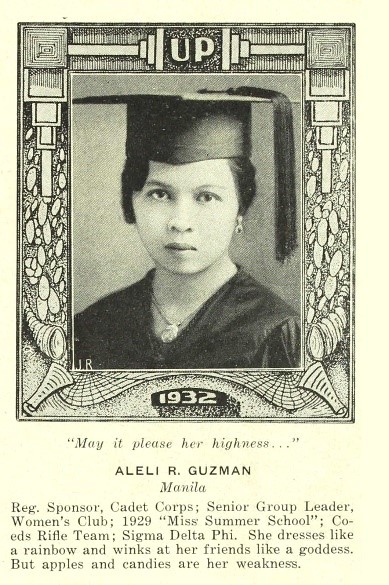
ALELI A. DE GUZMAN (QUIRINO)
Already having received an Associate in Arts by 1930, she continued studying at UP. She was attractive and popular. In 1929 she had been Miss Summer School. She later became a Corp Sponsor of UP Vanguard, Senior Group Leader of the campus Women’s Club, a member of the Coeds Rifle Team, and an Upsilon Fraternity Sweetheart.
Persuaded in 1932 to enter the Manila Carnival contest, she was crowned Miss Visayas prior to receiving her Bachelor of Science that same year. Aleli Regina graduated in 1937 with double degrees in chemistry and medicine. She ranked among the top ten when she passed the medical board examination and was the first Filipina surgeon to perform an abdominal operation in the country.
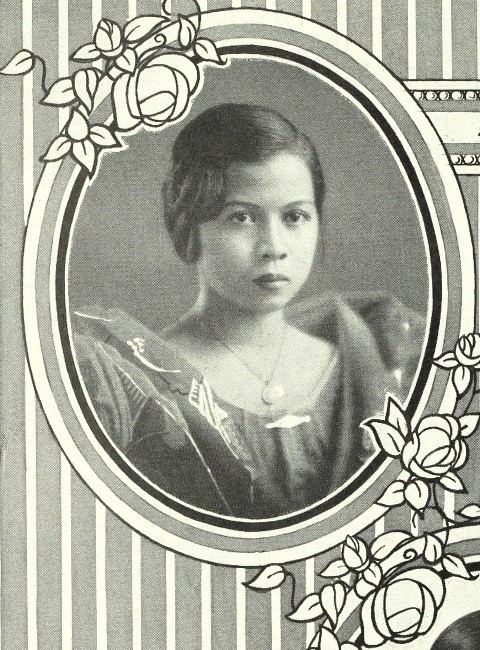
Born in 1911, Aleli Regina was the daughter of Angela Aguilar and one of the first Filipino accountants, Fortunato de Guzman. She married Antonio Rivera Quirino, a member of Upsilon Sigma Phi since 1926 and the younger brother of Philippine President Elpidio Quirino. He became chairman of Alto Broadcasting System that merged with Chronicle Broadcasting Network into ABS-CBN. In 1959, Aleli’s deepening concern for those in need inspired her to found a one-room free clinic in San Juan that grew into the San Martin de Porres Free Charity Hospital which she served as Clinical Director. She received a Mariang Maya Award for Humanities and Community Development in 1983.
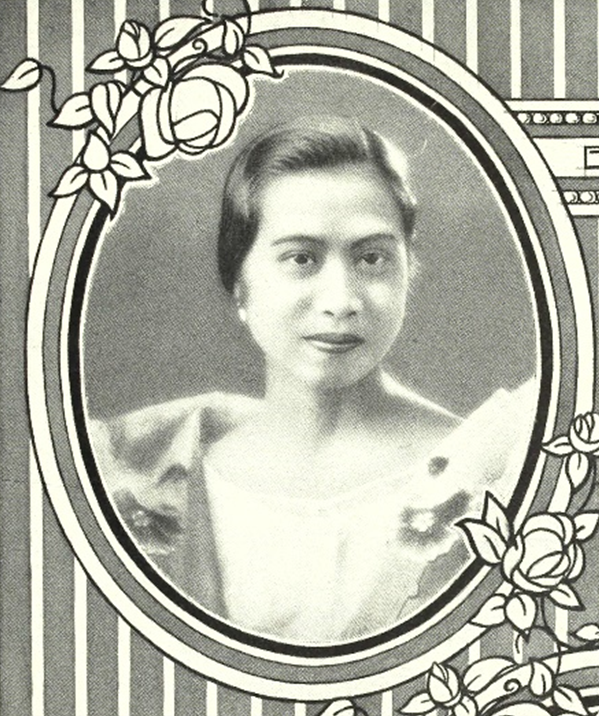
ELVIRA R. DE GUZMAN (LAO)
Elvira graduated in 1933 with a Bachelor of Philosophy. She resided in San Roque, Cavite City and was a classroom teacher at Cavite National High School in Cavite City.
Upon graduation she was Vice President of UP Women’s Club and Editor-in-chief of The Philippinensian, 1932-1933.
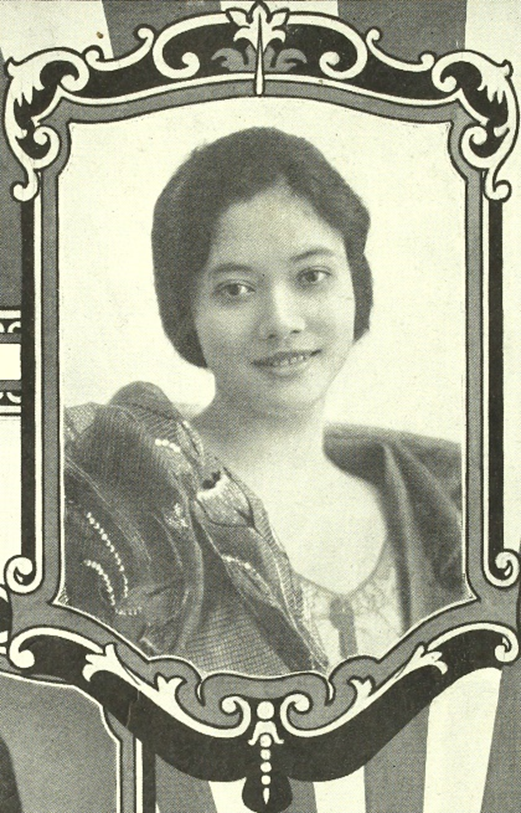
MARIA V. KALAW (KATIGBAK)
When Mary joined the Sorority, she already had received her Associate in Arts in 1930. While a student in 1931, she became the Manila Carnival Queen garnering close to 1 million votes ahead of the next candidate. She earned her Bachelor of Philosophy the next year. Upon graduation, she was given the Most Distinguished Senior Student Award. She was dubbed “winsome Queen Mary, muse of artists and poets, the despair of campus ‘shieks’.”
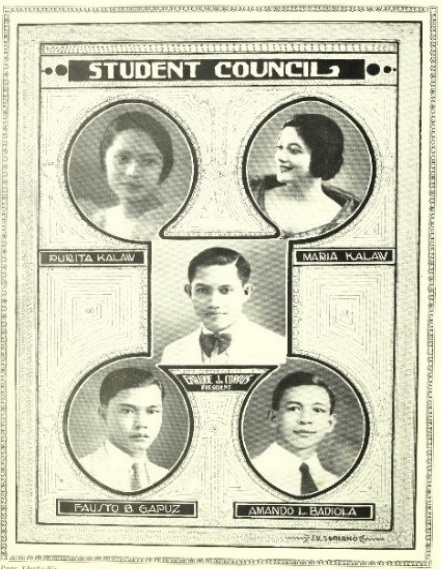
Maria Kalaw was an outstanding coed serving as a writer and Society Editor for The Philippine Collegian;UP Women’s Club President; Feature Editor of The Philippinensian; UP Debating Club Secretary; as well as a member of the UP writers and dramatic clubs.
In 1930-1931, she and her equally talented younger sister Purita served on the Student Council concurrently.
Mary would finish a Master of Arts in literature from University of Michigan and a Doctor of Philosophy in social studies, magna cum laude, from University of Santo Tomas. She married the obstetrician and gynecologist Jose Roxas Katigbak and, from 1961 to 1967, served as a Philippine senator.
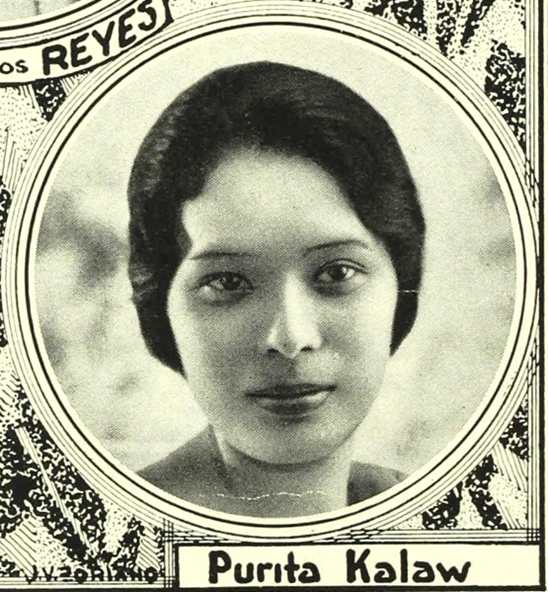
PURITA V. KALAW (LEDESMA)
When Purita became a Charter Member she already had UP degrees in Painting (1929) and Fine Arts (1932). She was a representative to the Student Council, 1930-1931; Battalion Sponsor 1931-32; and member of the Senior Council 1931-1932. From 1932 to 1933 she finished Decorative Design studies at University of Michigan. Returning to UP she worked for a Bachelor of Science in Education earned in 1936. She had been Muse for the Law Bachelors, 1934-1935; Lakambini of Nucleo Solteril, 1934; Secretary of Rho Alpha, 1934; and a member of the Kahirup Club, 1934.
She designed the sorority pin still worn today.

Purita married Rafael Ledesma. She founded Art Association of the Philippines and promoted Modern Art in the country. In 1983 she received a Golden Mariang Maya Award and in 1993, a Mariang Maya Award for Arts Development.
While she and her sister Mary were at UP, their father was Director of the National Library. He had been its first director in 1916, served as Interior Secretary in 1920, and in 1922 was appointed Executive Secretary and Chief Advisor for the Commission on Independence.
Their mother, Purificacion Villanueva was the Queen of the Orient at the first Manila Carnival held in 1908, a writer and a suffragist. Their younger sister Evelina joined the Sorority in 1936.

ISABEL L. LEAGUE (OLIVEROS)
After earning a Bachelor of Laws in 1933, she married Salvador Oliveros. They made a home in Santa Rosa, Laguna where she was Treasurer of Santa Rosa High School.
Although Sigma Delta Phi emphasizes the importance of dramatics and fine arts toward a complete education, its members are drawn from students of humanities and sciences. The Sorority hosted cultural events that the UP community enjoyed during Peacetime.
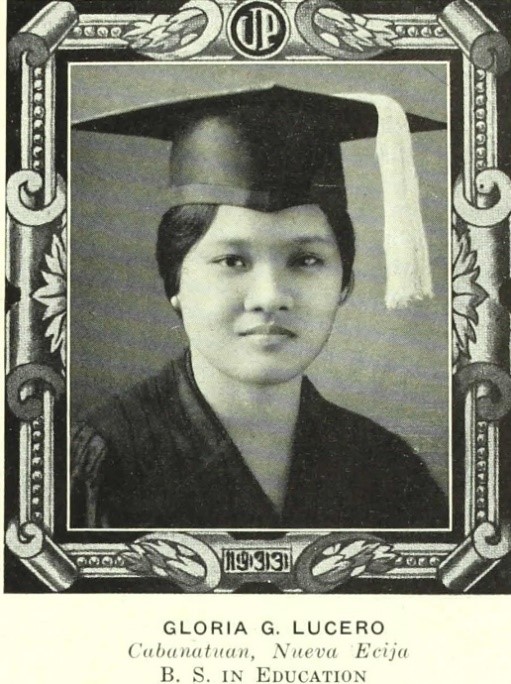
GLORIA LUCERO (MONZON)
Gloria is one of Sigma Delta Phi’s four founders. In 1933 she finished her Bachelor of Science in Education and began a career that included being a professor at Far Eastern University’s Institute of Education. The Philippinensian for 1933 singled out her kindness, ever ready smile, and helpfulness. She was Women’s Club treasurer, Vice President for the Juniors, and Sigma Delta Phi Vice Archon.
No timid coed, she expressed her thoughts and spoke with male students as an equal.
Born in San Isidro, Nueva Ecija, Gloria was the fourth of seven children. Her parents were Florentina Guzman and Senator Santiago Lucero, who had passed away in 1925. In 1939 her sister Simona joined the Sorority.

Gloria married Pat Monzon who rose in the ranks to become a general and Vice Chief of Staff of the Philippine Armed Forces. With daughters, granddaughters, and great-granddaughters becoming Sigma Deltans, Gloria kept close ties with the Sorority until her death in 2012 when she was 101 years old.
Gloria was a strong, liberal woman ahead of her times.
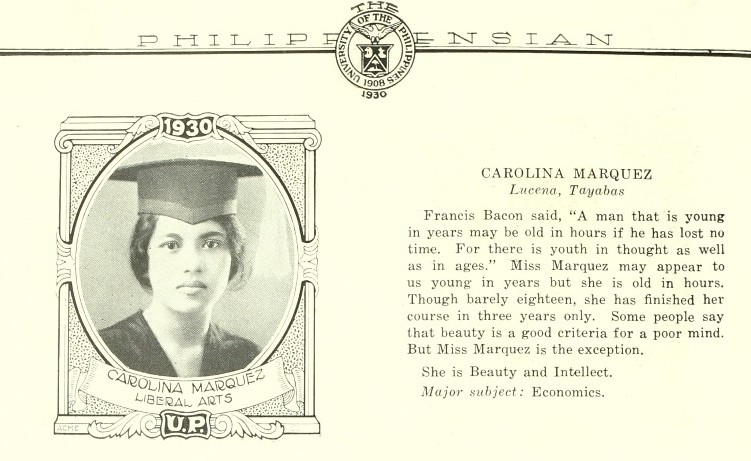
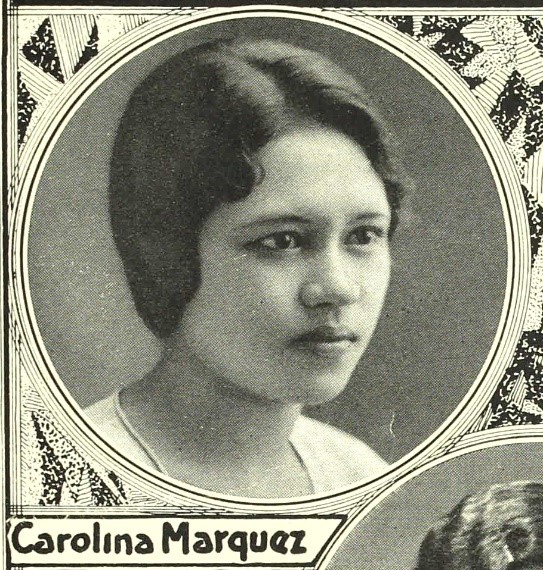
Bottom: P1932: 461
CAROLINA J. MARQUEZ (OLIVERA)
Lina received a Bachelor of Philosophy in 1930 and a Master of Arts in 1933. The Philippenensian 1930-1932 commended her finishing the liberal arts course, with a major in economics, in only three years and at the age of 18. She was cited as a woman of beauty and intellect.
Born in Lucena, Quezon in 1911, Lina is the daughter of schoolteachers Maria Nicomedes Jurado and Gregorio Lopez Marquez. One of her 11 siblings is the distinguished writer Paz Marquez-Benitez who co-founded Philippine Women’s University in 1919.
In 1930 the Marquez sisters established St. John’s Academy in San Juan City where Lina taught English literature. She married Baldomero Olivera. Their only child is Baldomero “Toto” M. Olivera an internationally eminent botanist.


Bottom: P 1934: 449. Event for Mrs. Teahan
GUADALUPE C. MORENTE (BARCELONA)
Guadalupe finished her Bachelor of Science in Home Economics. Pinamalayan, Oriental Mindoro was her home address at the time.
When she graduated in 1934 she was Treasurer of Club Cervantino; Women’s Club Secretary; Sigma Delta Phi Secretary; Secretary-Treasurer of the Senior Organization; Secretary of the Senior Council; Assistant Business Manager of the 1934 Philippinensian; UP Home Economics Club President; and a member of the St. Catherine’s Club.
She typified the young leaders needed in all the provinces for the country’s success.
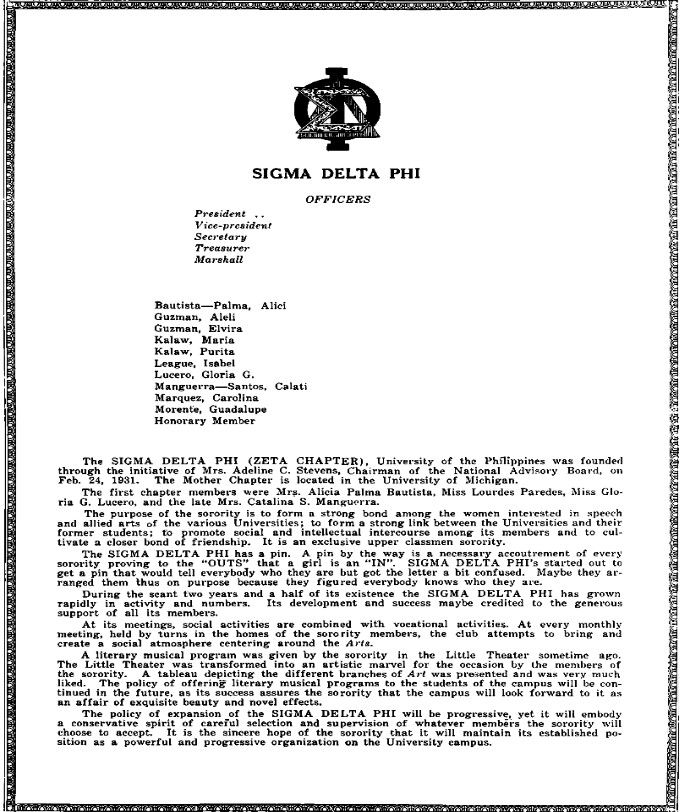
ALICIA O. PALMA (BAUTISTA)
Alicia is a co-founder of the Sorority. She finished a Bachelor of Science in Home Economics in 1929. Her career was spent as a scientist for the Food & Nutrition Research Center, National Institute for Science and Technology of the National Science and Development Board in Manila.

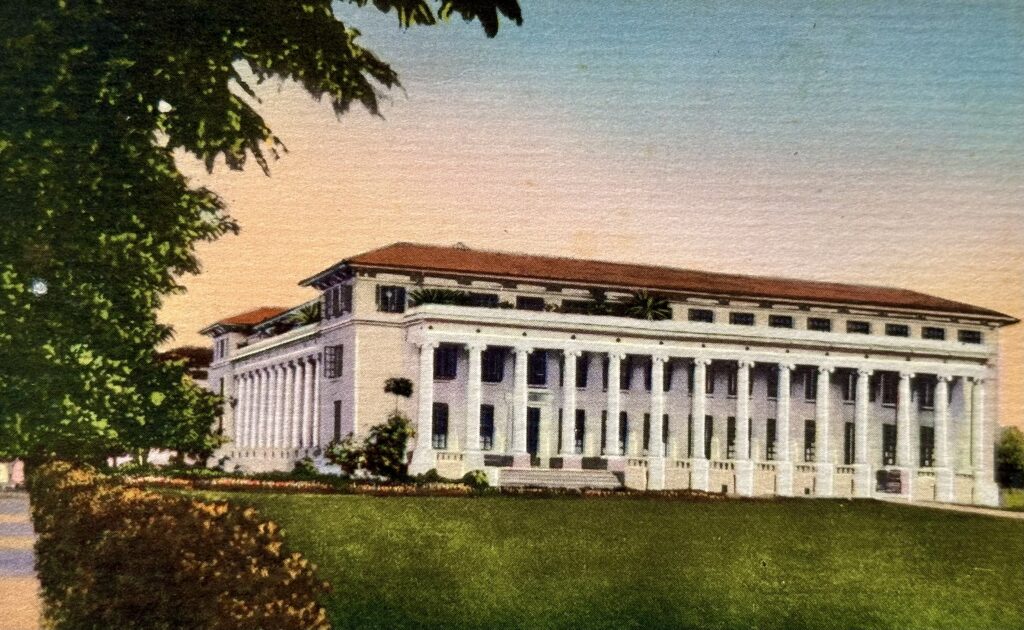
Alicia was a daughter of Rafael Palma (1874-1939), the fourth UP President (1925-1933) who had been a senator, 1916-1921. Her mother Carolina Ocampo came from a nationalist family; her father was Martin Ocampo, administrator of the newspaper El Renacimiento, and who had been deported to Guam by the US government.
Alicia married the architect Nicanor Bautista. One of her sisters, Fe, became a Sorority Charter Member.

FE O. PALMA (ZAIDE)
Fe was a sister of Alicia Palma. She finished her Bachelor of Science in Education. Upon graduation in 1934, Fe was on The Collegian staff; Vice President of the College Editors’ Guild; Vice President of the Dramatic Club; Vice President of St. Catherine’s Club; and Secretary of the Women’s Club.
She became a career diplomat serving as Second Secretary and Consul for the Philippine Embassy at The Hague in Holland. In 1967 she married Press Attaché Jose Zaide witnessed by Carlos P. Romulo, Secretary of Education, who had been Philippine Ambassador to the United States from 1955 to 1962 and who became Secretary of Foreign Affairs for several terms.

P 1936: 307
LOURDES PAREDES (SAN DIEGO)
In 1933, Lourdes became the first Grand Archon. She already had an Associate in Arts given in 1929 and a Bachelor of Philosophy in 1932 . When she joined, Lourdes was working for her Bachelor of Laws that she received in 1933 cum laude and as class valedictorian.
She became a Judge at the Court of First Instance beginning in 1958 till 1970. Then she served as an associate justice for the Court of Appeals until 1980 when she was appointed the first woman Presiding Justice at the Court of Appeals. In 1983, she received a Golden Mariang Maya Award.

Lourdes pursued her keen interest in music and finished a Bachelor of Science in Music majoring in piano at St. Theresa’s College.
Her father, Quintin Paredes, had been congressional representative of Abra at large since 1925. By the time she became a Sigma Deltan he was Speaker of the House but resigned in 1936 to become the first Philippine Resident Commissioner in the United States.
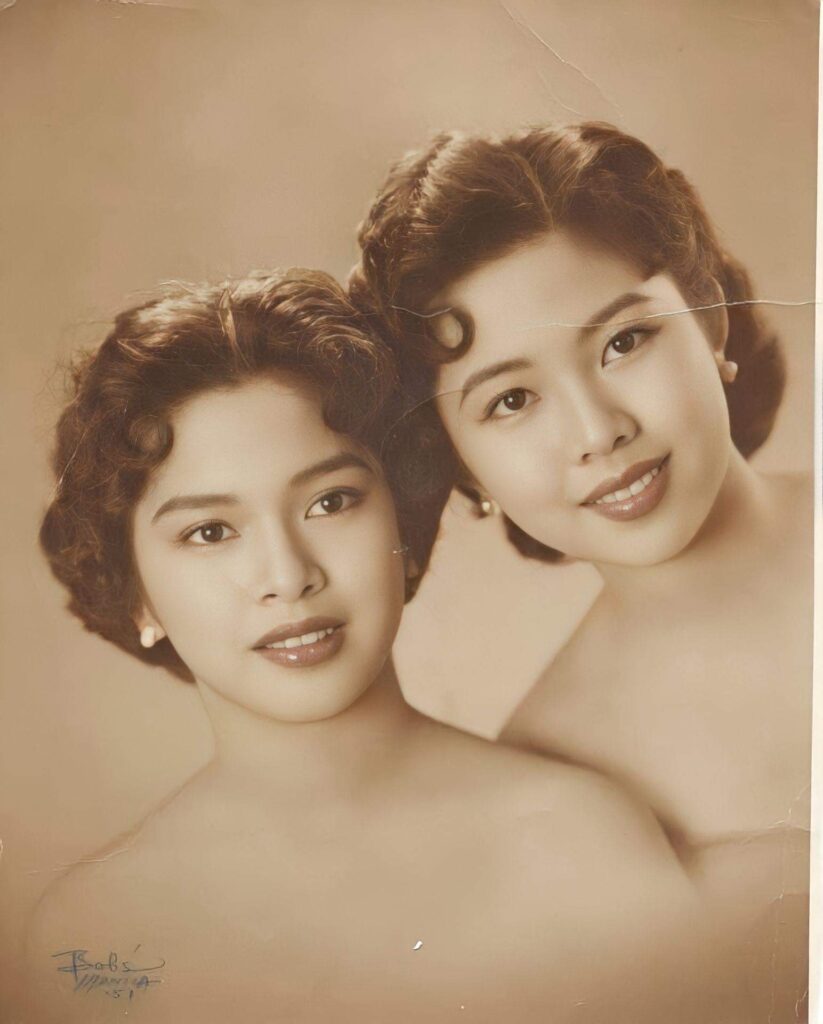
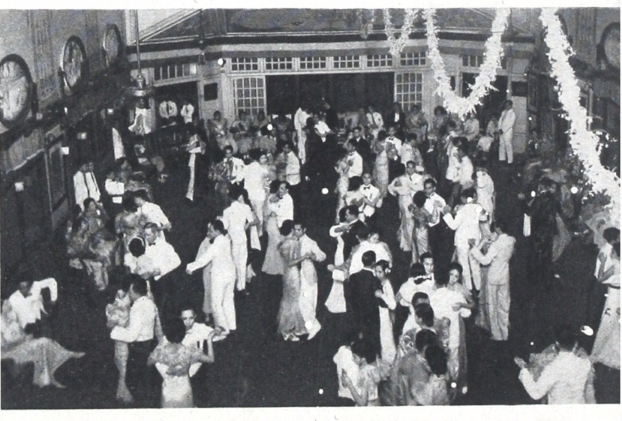
Bottom: P 1936: 298. Cheek to cheek
JOSEFINA R. SANDOVAL (TAMBUNTING)
This Charter member received her Bachelor of Science in Education in 1931 and was a career educator. She taught at Far Eastern University’s Institute of Arts & Sciences in Manila.
While no photo of her as a coed has yet been found, one wonders if she resembled her two beautiful daughters shown as young women.
UP education included learning the etiquette for formal banquets. Ballroom instruction was also given. “Mentors as guardians of student morals prescribe less dance… But as long as youth is young, there will be more balls…. We are young only once,” notes a Philippinensian article in 1936. Shown is dancing cheek to cheek, popular at the time.

LILIA ALICIA M. DE SANTOS (TANTOCO)
She was the daughter of Sabina Mauricio and the distinguished Isidoro Ongsiaco de Santos (1873-1939), a physician who was elected representative of the 1st District of Manila in 1912 for the Philippine Assembly.
In 1935, after she had joined Sigma Delta Phi, her father commissioned well-known German architect Arthur Julius Gabler-Gumbert to design the Ides-O’Racca Building, that was both rentable space and the family’s residence on Aceiteros Street in gentrified San Nicolas, Manila. The street was renamed Marcelino de Santos in honor of her grandfather who was imprisoned for supporting the Philippine Revolution.
She married Alfonso Tantoco. Like other Charter Members, Lilia Alicia and her sister Pilar, also a Charter Member, established the Sorority’s pedigree that would be patinated over scores.

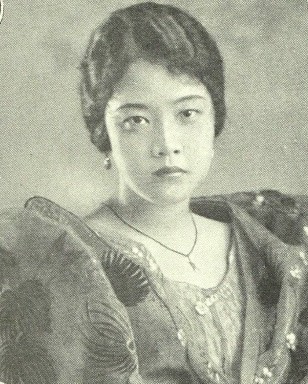
Bottom: P 1931: 412
PILAR M. DE SANTOS (CRUZ)
Pilar, a sister of Charter Member Lilia Alicia, finished her Bachelor of Science in Business Administration in 1931 and married Andres Cruz.
The Philippinensian 1931 includes a critique of her stage activities: “Pilar de Santos is not in college dramatics. But undisputed from the time she was a student in U.P. High to her graduation this year, she has held the premier honors in classical dancing, an art which calls for perfect coordination of the body, rhythm and imagination.”
She was credited with “a quiet dignity in her movement and arresting meaning in her poses like the murals of Enrique L. Ruiz, and a subtleness in her translation of the dance pattern.” Clearly she was a campus star.

LAURE SATTERTHWAITE
She is shown here, standing at the far right, in a group photo of sisters dated 1933. However, research has hit a cold trail in learning about this Charter Member. There is a stunning portrait of Frances Lourdes Satterthwaite-Amechazurra painted by Fernando Amorsolo dated 1949. Perhaps Laure was related to Frances Lourdes.
We are still reaching out to potential descendants.
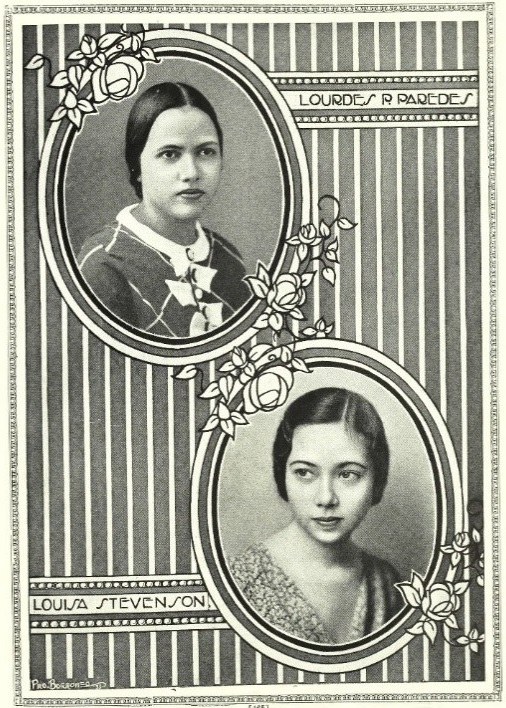
LOUISA STEVENSON (ISIDRO)
Lou is a Sorority co-founder. When she graduated in 1933 with a Bachelor of Science in Education she was President of UP Woman’s Club, Education Representative to the Junior Council, Secretary of the Dramatic Club, and Vice President of the Home Economics Club. She was said to smile but never laugh in the 1933 Philippinensian.
She taught Home Economics at UP until she married Antonio Santos Isidro (1900-1996) who became the first president of Mindanao State University (MSU) founded in 1961. He had been Vice President for Academic Affair of UP prior to the position.
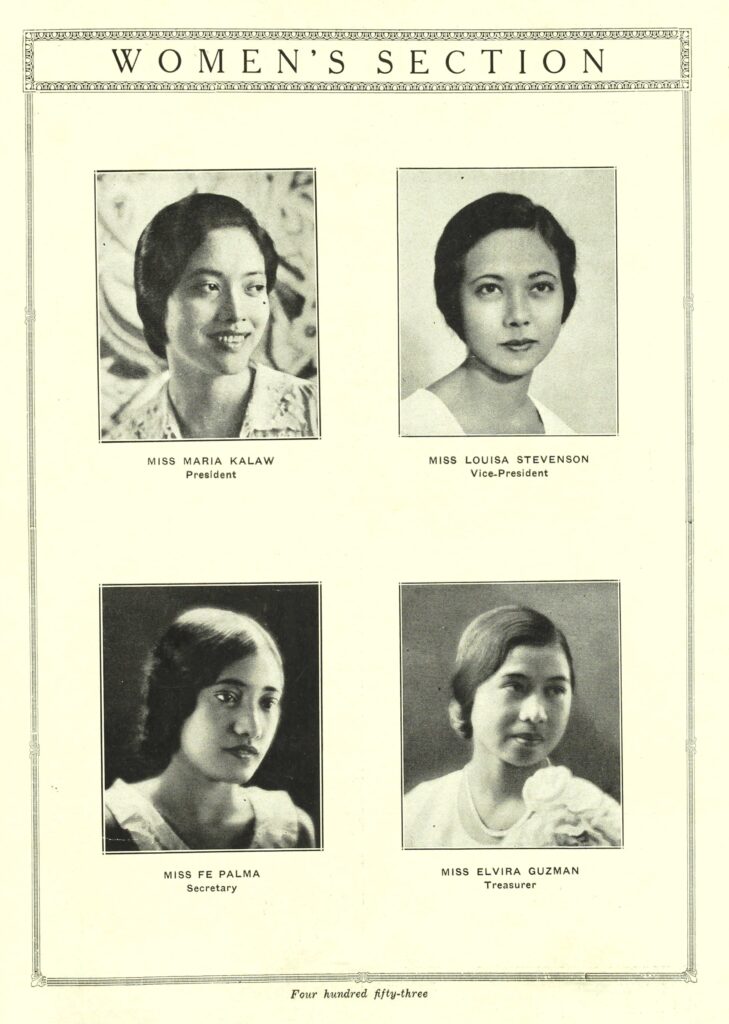
Born in Tarlac in 1911, Lou was the daughter of James William Stevenson who in 1898 joined the United States Army as a private in the 1st Regiment of the Montana Infantry. After his discharge, he stayed on in the Philippines. In 1907 at the age of 42 he married 18-year-old Miguela Gonzales y Libunao of San Miguel, Bulacan with her mother’s consent.
By 1921 the couple had moved to San Juan Hills and Stevenson owned Manila Installment Company (MINCO) that was among the first businesses to offer credit-buying of furniture to the average Filipino.
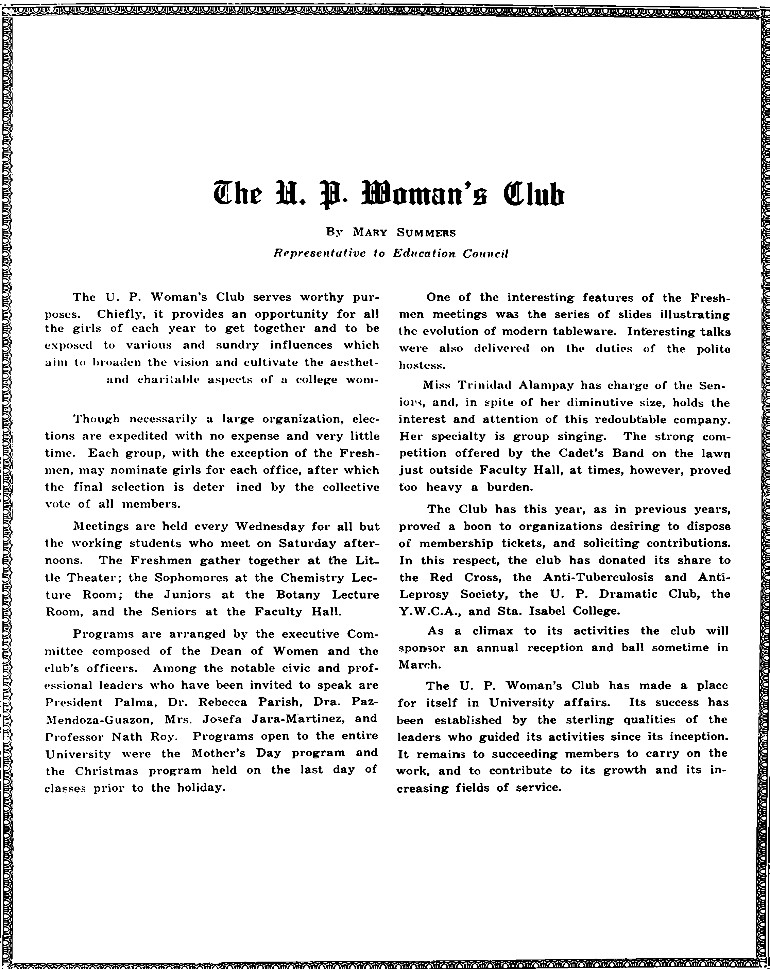
MARY A. SUMMERS
Mary’s father George Robert Summers volunteered to help establish the Philippine public school system and in October 1901 was assigned to Cauayan, Ilocos Sur as a teacher. He married Trinidad Guerrero Agcaoili of a prominent llocano family. The couple moved to Manila where he became Superintendent of Schools and Assistant to the Director of Public Schools. They lived at 512 San Luis Street (T. Kalaw Street today), Manila and perhaps were there while Mary was at UP.
In 1933, she earned her Bachelor of Science in Education. Upon graduation, Mary was on the Girls’ Tennis Team and Secretary of the Dramatic Club where she was considered a “reliable” member.
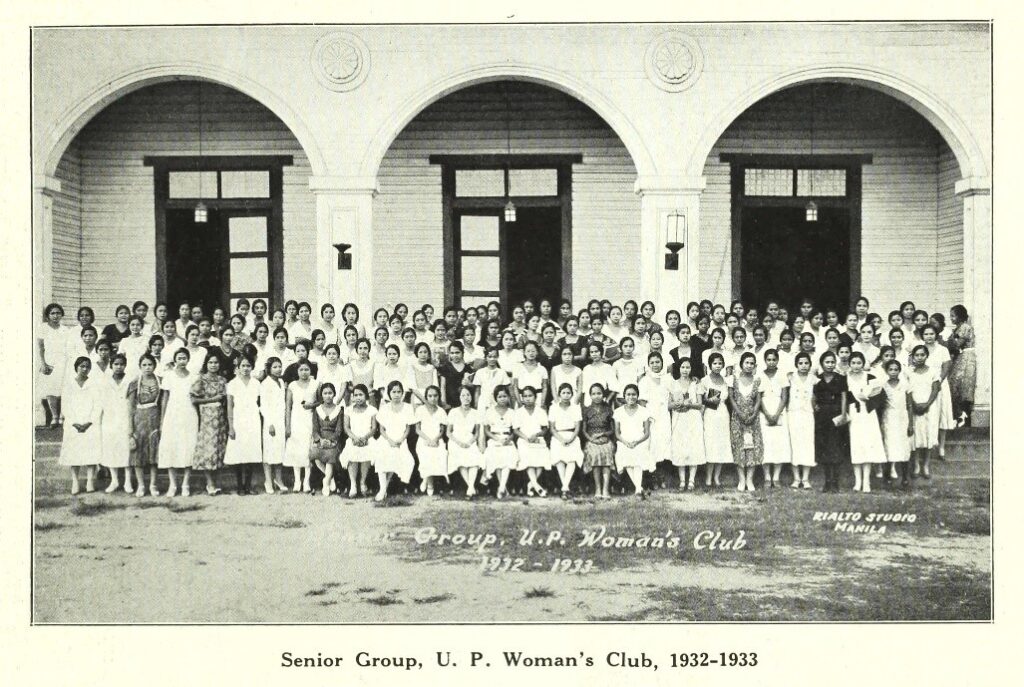
In 1933, Mary was the UP Woman’s Club Representative to the UP Education Council. She had been its Vice President in 1932 when her Sorority sisters were also officers: Maria Kalaw, President; Fe Palma, Secretary; Elvira de Guzman, Treasurer.
The UP Women’s Club was one of the largest if not the largest student organization of the university. To be one of its official, what more it president, was significant. The Women’s Club had members reaching at least 900. By contrast, Sigma Delta Phi had a limited membership. The first batch had 22 sisters. There were 7 sisters in Batch ‘34; 14 in ‘35; 7 in ‘36; 2 in ‘37; 12 in ‘38.
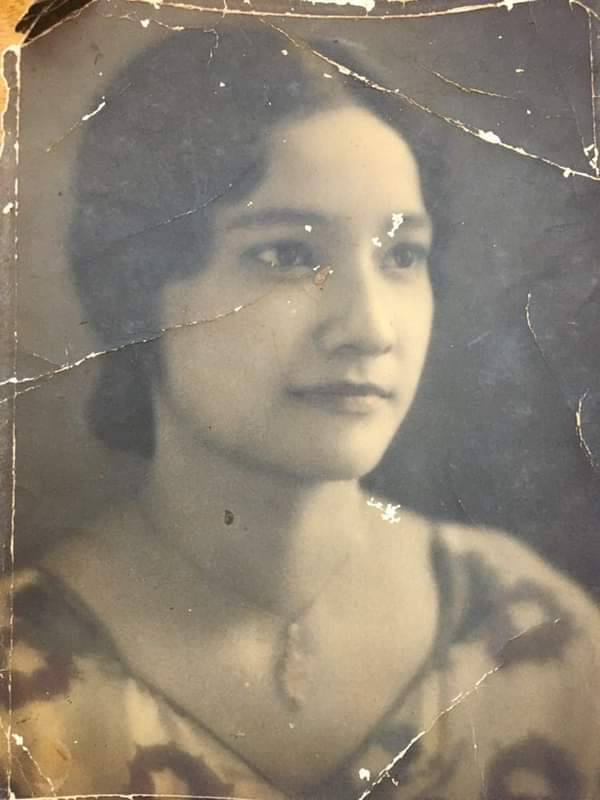
SARAH L. TEMPONGKO (DE LA PAZ)
When in 1931 Sarah received her Bachelor of Science in Education she was cited as having been Chairman of the UP Women’s Club Seniors’ Executive Committee, 1930; Secretarv, Education Seniors; Secretary, Dramatic Club 1929; a member of the Rifle and Pistol Team, 1929; and the Rizal Center Sorority. She majored in English and minored in Economics.
The Philippinensian 1931 credited Sarah as the “best artist in college dramatics for years. She starred in “The Husband of Mrs. Cruz,” “Waves,” as well as “Love and Patriotism.” It added that she was the” winsomest star in college dramatics, wistful as a lighted candle, and adorable as a birthday gift.”
Born in 1907 to Leocadia L’Heritier and Felipe Calixto Tempongko, she married Angel de la Paz. Two daughters became Sigma Deltans.
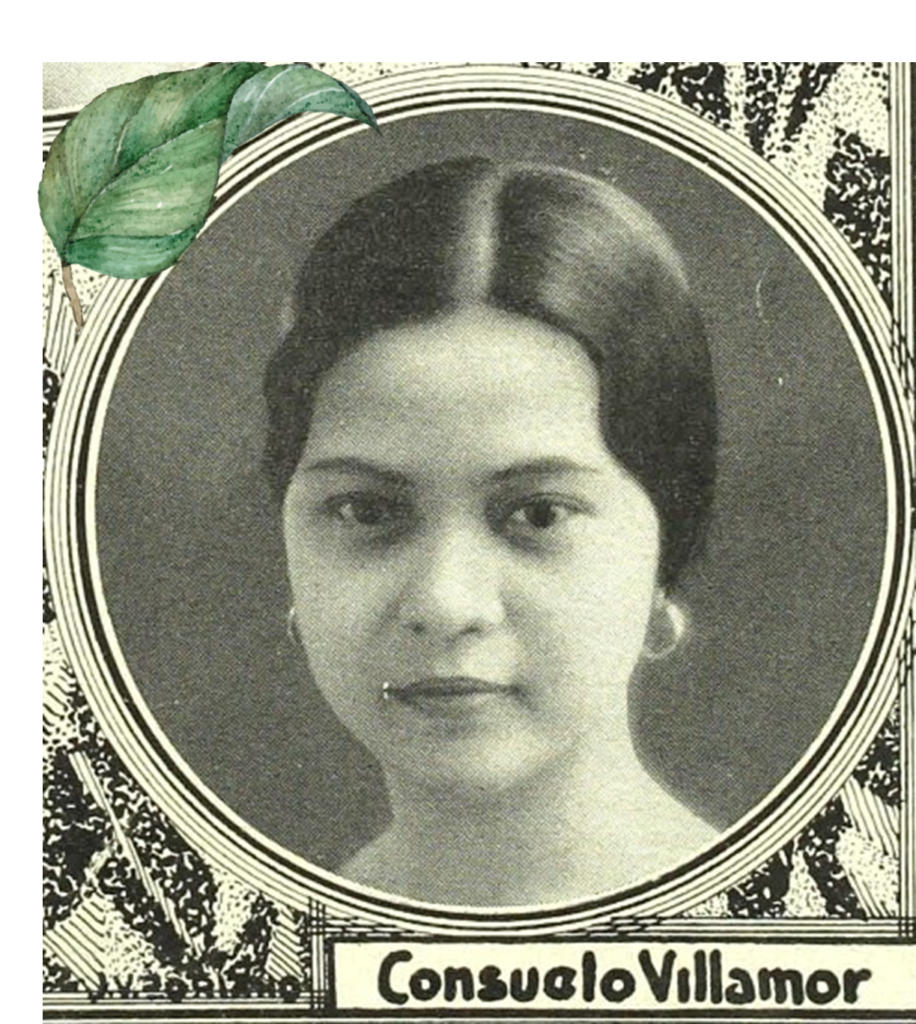
CONSUELO M. VILLAMOR (ASIS)
Consoling earned her Bachelor of Science in Education in 1932 and her Master of Arts in 1938. At UP she was a cadet sponsor of the UP ROTC, an honor reserved for accomplished campus beauties. UP chose her as its candidate for the 1934 Manila Carnival contest. She was crowned Miss Mindanao. Born in Banqued, Abra to Pedro and Josefa Villamor, she was no stranger to beauty contests having been elected Miss Abra prior to her UP days.
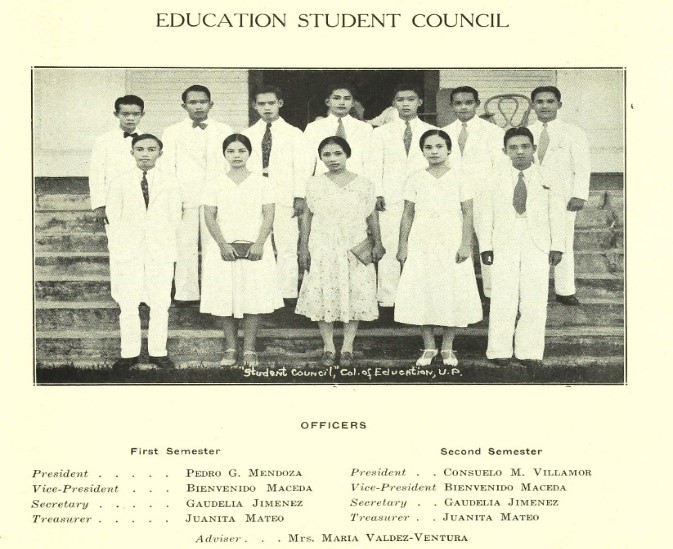
On campus, Consoling served as Secretary of the Junior Class Organ, 1930-1931; Biology Club Secretary; Representative to the Senior Council; and Assistant Business Manager of The Philippinensian. “In her own quiet way, she has contributed much to the progress of literature and oratory – by way of inspiration,” noted the yearbook when she graduated.
Abraham A. Asis became her husband. She became Chairman of the Biology Work Group for the UP Science Education Center and worked as an Associate Professor at the UP Department of Botany. She was such a noted academic that UP named her a professor emeritus.
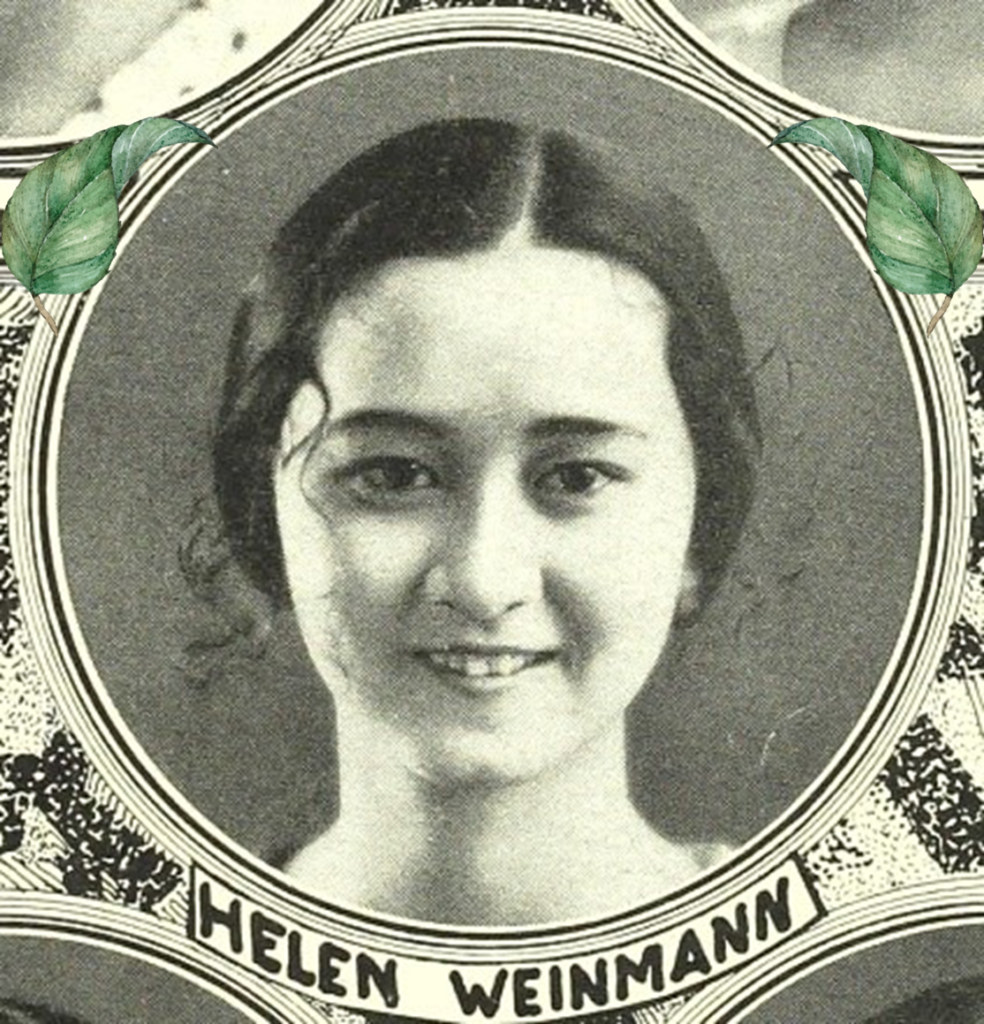
HELEN WEINMANN (SCHENKER)
In 1947, a 35-year-old Swiss citizen of German descent, Helen Weinmann Schenker sailed on the S.S. America from Cherbourg, France for the United States where she was to visit her brother in law, Alphons Mursaler of New Rochelle, New York. She was 35 years old, fair with brown eyes and black hair, standing 5 feet and 1-1/2 inches. Noting her occupation as housewife, she had been born in Manila in 1912.
She was likely the Sorority’s Charter Member.
Research on the pioneering years of Sigma Delta Phi is a continuing work in progress.
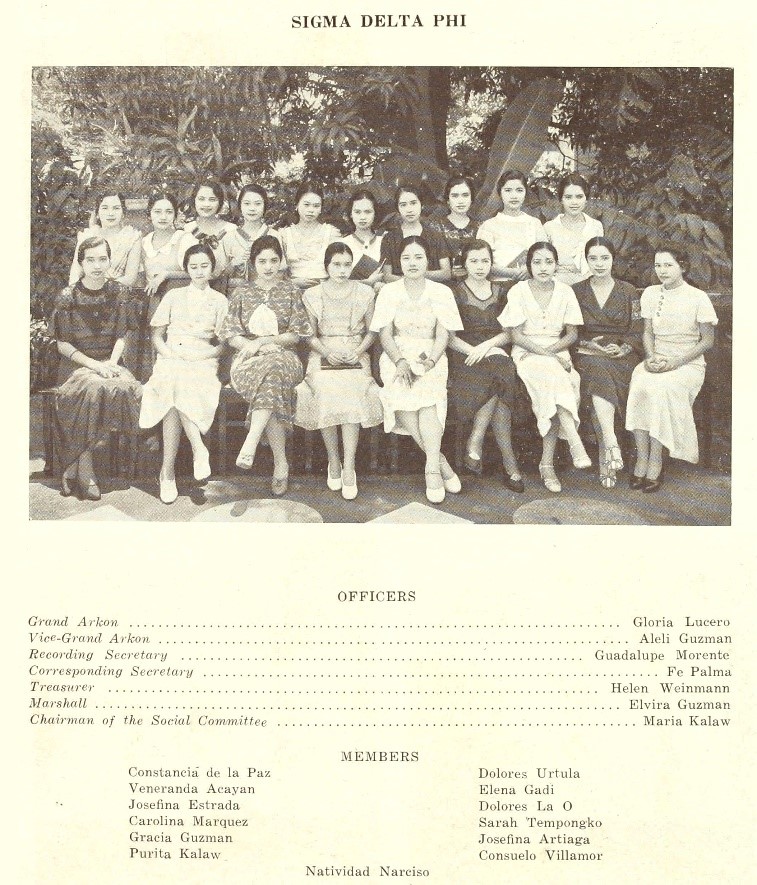
Sigma Delta Phi rooted firmly in UP.
By 1934, seven new sisters were added:
Veneranda Acayan
Josefina Artiaga
Gracia Guzman
Flores Lao
Natividad Narciso
Constancia de La Paz
Dolores Urtula
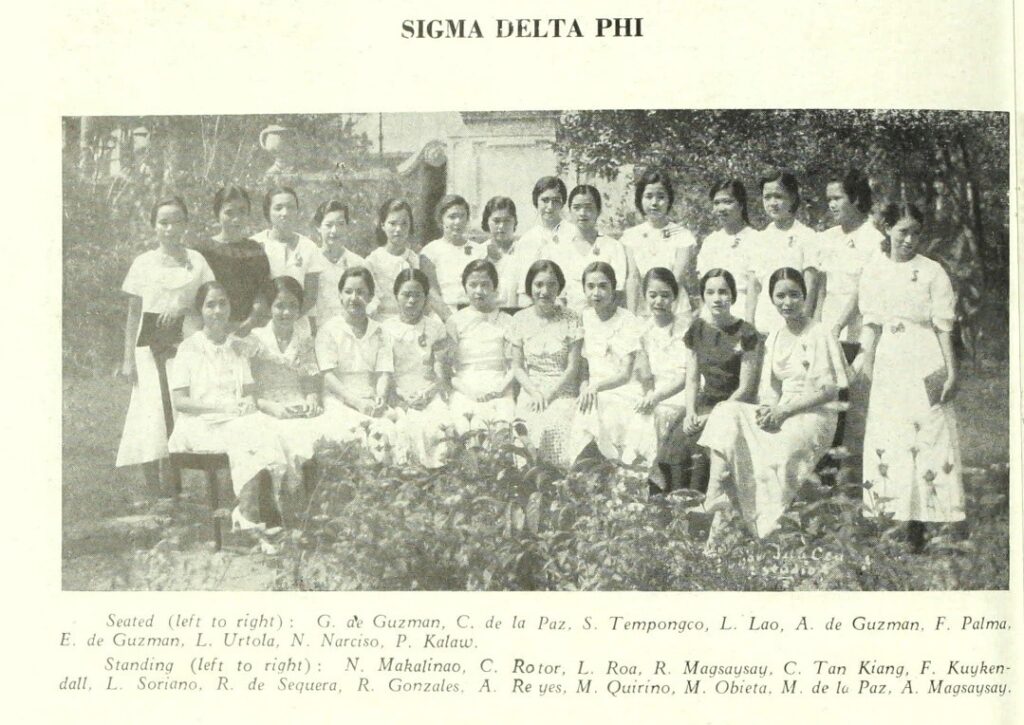
The heirloom photograph is from 1935 with the year’s new batch of fourteen coeds. The Sorority was led then by: President, Aleli de Guzman ’33; Vice-President, Sarah Tempongko ’33; Recording Secretary, Purita Kalaw ’33; Corresponding Secretary, Constancia de la Paz ’34; Treasurer, Dolores LaO, ‘34
Seated (L-R): Gracia de Guzman ‘34, Constancia de la Paz ‘34, Sarah Tempongco ‘33, Dolored Lao ‘34, Aleli de Guzman ‘33, Fe Palma ‘33, Elvira de Guzman ‘33, Dolores Urtula ‘34, Natividad Narciso ‘34, Purita Kalaw ‘33
Standing is the full Batch ‘35 (L-R): Nieves Makalinaw, Corazon Rotor, Leticia Roa, Ramona Magsaysay, Clarita Tan Kiang, Flora Kuykendall, Lily Soriano, Ramona de Sequera, Rosa Gonzales, Amelia Reyes, May Quirino, Marina Obieta, Matilde de la Paz, Anita Magsaysay

Sigma Delta Phi began with 22 charter members of distinguished parentage, but what made them campus stand-outs was their personal accomplishments while students at University of the Philippines.
Every year since 1933 new women continue adding their promise, achievements and aplomb to Sigma Delta Phi, a sisterhood for life.
